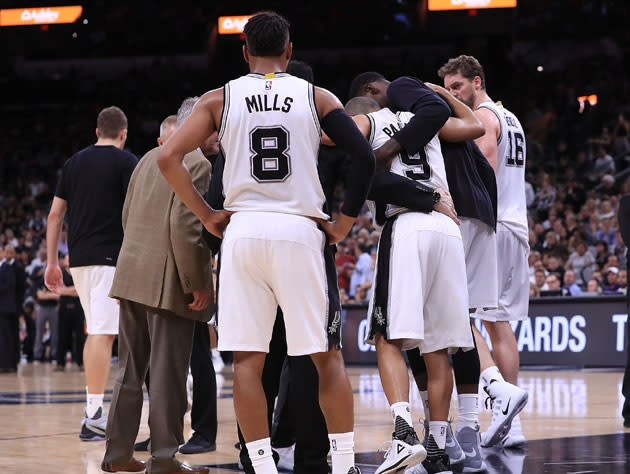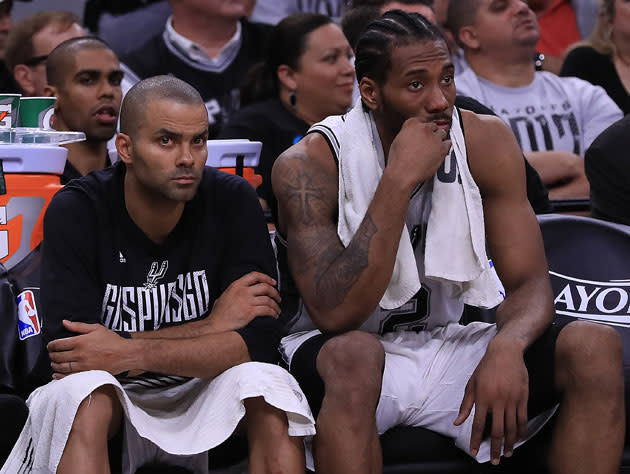Tony Parker's quad injury leaves an uncertain future for both Parker and his Spurs

Nothing can drag the heart out of the San Antonio Spurs, each vital organ is indistinguishable from the next at this point, but this certainly hurts.
[Follow Ball Don’t Lie on social media: Twitter | Instagram | Facebook | Tumblr]
Star guard and five-time champion Tony Parker will not only miss the remainder of the 2016-17 postseason with a quadriceps tear, as first reported by Adrian Wojnarowski at the Vertical, but potentially a portion of 2017-18 as well. Though several NBA athletes have returned to full strength from varying degrees of quad setbacks, Parker’s age and the severity of the tear make it so his NBA future is very much in doubt.
Due to turn 35 on May 17, Parker’s MRI results revealed no significant knee ligament damage, but a potentially career-stopping quadriceps tear:
Tony Parker Injury Update: pic.twitter.com/i3SUAo9Map
— San Antonio Spurs (@spurs) May 4, 2017
Quad tears are typical for older athletes, and they can take six-to-12 months to return from.
On one end of the spectrum was Blake Griffin’s quadriceps tear from late 2015, one that was due to sideline him “at least two weeks” prior to a return date that was pushed back due to a hand injury suffered a month later in an off-court incident. Even three months after the tear Griffin submitted that the quad had not fully healed, though the Clippers forward showed no ill effects from the injury upon returning in 2016-17.
Charles Barkley tore his quadriceps at age 36, he was a full decade older than Blake Griffin was at the time of his injury. That setback, suffered in 1999-00, signaled the end of Barkley’s career.
Parker suffered the tear during the fourth quarter of his team’s impressive 121-96 victory over the Houston Rockets on Wednesday, tying the teams’ semifinals series up at 1-1.
In the midst of a stellar, throwback night for the 34-year old, Parker’s night and season ended on this play:
Following the contest, longtime San Antonio coach Gregg Popovich confirmed what was obvious even from the televised angle, upon seeing that patella tendon pushed too far down Parker’s left leg:
Popovich on Tony Parker: "It's not good" #Spurs #Rockets
— Jabari Young (@JabariJYoung) May 4, 2017
Game 3 of San Antonio’s series with Houston tips off on Friday, with potent reserve Patty Mills likely taking the starting role. Mills shared the court with Parker when the 16-year veteran went down with his injury in the fourth quarter on Wednesday, and he sat for most of the extended blowout action as the final quarter dwindled in San Antonio’s one-sided win, but not before Mills once again began stirring San Antonio’s drink as the team moved toward a decisive Game 2 win.
A lineup featuring Kawhi Leonard, Pau Gasol, Jonathan Simmons, Danny Green and a combination of Mills or Manu Ginobili helped push San Antonio toward its strongest edge in Game 2, with a 19-0 run fashioned immediately after Parker left the contest. How Spurs coach Gregg Popovich saves those sorts of special lineups, and whether or not those lineups can remain “special” after the Rockets get a few days to consider life against the Parker-less Spurs, remains to be seen.

Mills is a skittery scorer, averaging 9.4 points but just (as is his role) 1.5 assists in 20 minutes per game off the San Antonio pine in the postseason. His presence, especially as noted during his spectacular Game 5 run against the Memphis Grizzlies one week ago, was sorely required even with Parker available for work in 2016-17: Tony averaged 10.1 points and 4.5 assists this season, his lowest marks since his rookie year in 2000-01.
Parker famously clashed with Gregg Popovich during that and most other seasons; due to his status as a third point guard, though, rookie Dejounte Murray hasn’t seen nearly as many public spats with Pop in 2016-17. The 20-year old started eight games for the Spurs this year, averaging 10.5 points and 3.5 assists in about 24 minutes a game while making half his shots from the field. He’s missed six of seven shots in his first postseason, though, scoring nine points to four assists and one turnover in 23 total minutes.
Popovich could start Murray, in a bid to sop up minutes with Kawhi Leonard and new starter Pau Gasol making plays, while retaining Patty Mills’ role with the bench units. Or, he could move to place 39-year old Manu Ginobili in the starting lineup, mindful of his work as a Parker-styled hybrid guard midway through the fourth quarter of Game 2. The future Hall of Famer could retire as perhaps the best Sixth Man in NBA history when his time is up, but hasn’t started an NBA game in 38 months.
Whatever the result, Tony Parker’s removal from the proceedings helps us dig in on what we already knew: Kawhi Leonard is going to have to sustain his marvelous, Jordan-like movements for the Spurs to survive and continue in its championship quest.
This isn’t just about beating the Rockets, though you know the dutiful Spurs locker room can’t imagine a world past Friday’s Game 3. Their focus may be steeled on the next task ahead, but outsiders shouldn’t lose sight of the image of San Antonio as championship contenders. Tony Parker has been brilliant during these playoffs in sustaining the Spurs attacking through his gliding, still-supreme pick-and-roll movements, but the San Antonio offense has enough quirks in it to fill up possessions knowingly.
It was Parker that was in charge for the 9-0 run to start San Antonio’s fourth quarter in Game 2, pushing the tempo and capping the spurt with an expert slip-and-roll pass to Pau Gasol for a two-handed dunk prior to a needed Houston timeout. Parker fell for good following a floater attempt on the next Spurs possession, necessitating Leonard’s insertion into the contest, and Patty Mills (already in the lineup) responded with some dogged play of his own before Popovich removed the reserve point guard in favor of the returning Ginobili.
With Kawhi mostly lording the show, alongside Gasol/LaMarcus Aldridge, Manu, hybrid forward Jonathan Simmons and Danny Green, the Spurs pushed the Rockets to the brink in Game 2. San Antonio extended its lead from 14 to 30 after Parker was carried off the floor, eventually settling on that 121-96 final after giving the Spurs more than enough hope (or, more importantly, fodder) for the future.
The Spurs stretched out that lead by continuing apace, slowing the actual pace and letting either Mills (either in screen and roll attacks or pell-mell, half-transition drives) crash or Kawhi Leonard work through his slow burn. The team will miss his loping play, but it will have options moving forward. Especially if rookie Dejounte Murray can soak up those extra minutes with solid-enough play, wherever those ticks come from.
The Spurs attempted to hide Parker on Eric Gordon in Game 2, with varying results (he finished 6-12 from the floor, 15 points), and San Antonio’s defense came to life in his absence. Leonard doesn’t have to act as the head of this slithery defensive unit nearly as often with Green and Simmons covering all angles, and even the aging Ginobili utilizing his long arms and timing to stay in front of potential leaks. The Spurs close out better, and they’re more easily able to switch without the 34-year-old on the court.

What happens at age 35 is far more frightening.
Though Parker made his 2001 emergence as a sprightly thing, he utilized savvy and guile in strong amounts even while ranking as the fastest player in the game – which he most assuredly has not been for many, many seasons. Coming off an era that saw teams routinely trot out All-Star point guards for over 40 minutes a contest, the Spurs minded TP’s minutes since the beginning, he’s never worked more than 34.4 minutes per game in a season.
He has worked a total of 212 postseason games, though, more than 2 1/2 seasons’ worth of play at 34.8 minutes per excruciating (well, some were) contest. Parker represented France during every other offseason in FIBA EuroBasket play alongside Olympic bouts, though he did retire from international play following the 2016 Olympics.
That’s a hefty back catalogue, one that no doubt contributed to Parker’s diminished (though not less respected) standing in 2016-17.
Parker is far more svelte and much younger than Charles Barkley was when he tore his quadriceps tendon back in 1999, but the point guard position demands far more cutting and chasing than any other position, tangible elements that can’t always be made up for with a bit of cunning. Barkley returned for a cameo appearance in one final game, months ahead of schedule, in what was only a ceremonial affair.
Parker, with a year left on a contract that guarantees him $15.4 million next season, won’t be counted on for mere applause breaks.
Backup Patty Mills (a free agent this summer) is not the point guard of the future, he is hardly a passer and turns 29 in August, while Murray failed to show significant signs during his rookie year at age 20. Quad tears are not a point guard’s injury to typically come back from, nor are they usually a 35-year-old’s injury to try and work through.
Those are two formidable tasks to work through at any level, let alone the NBA’s. Only a too-long summer will tell us what Tony Parker’s future has in store, but whatever the turnout we can assume that his next few months will contain a struggle.
The same will go for the team he’s left behind.
– – – – – – –
Kelly Dwyer is an editor for Ball Don’t Lie on Yahoo Sports. Have a tip? Email him at KDonhoops@yahoo.com or follow him on Twitter!

